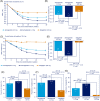Efficacy and safety of once-weekly semaglutide versus once-daily sitagliptin as add-on to metformin in patients with type 2 diabetes in SUSTAIN China: A 30-week, double-blind, phase 3a, randomized trial
- PMID: 33074557
- PMCID: PMC7839591
- DOI: 10.1111/dom.14232
Efficacy and safety of once-weekly semaglutide versus once-daily sitagliptin as add-on to metformin in patients with type 2 diabetes in SUSTAIN China: A 30-week, double-blind, phase 3a, randomized trial
Abstract
Aim: To evaluate the efficacy and safety of once-weekly subcutaneous semaglutide, a glucagon-like peptide-1 (GLP-1) analogue, versus once-daily sitagliptin as add-on to metformin in patients with type 2 diabetes (T2D) in a multiregional clinical trial.
Materials and methods: In the 30-week, randomized, double-blind, double-dummy, active comparator SUSTAIN China trial, 868 adults with T2D inadequately controlled on metformin (HbA1c 7.0%-10.5%) were randomized to receive once-weekly semaglutide 0.5 mg (n = 288), semaglutide 1.0 mg (n = 290) or once-daily sitagliptin 100 mg (n = 290). The primary and confirmatory secondary endpoints were change from baseline to week 30 in HbA1c and body weight, respectively.
Results: The trial enrolled ~70% (605/868) of the patients in China, and the remaining patients from four other countries, including the Republic of Korea. Both doses of semaglutide were superior to sitagliptin in reducing HbA1c and body weight after 30 weeks of treatment. The odds of achieving target HbA1c of less than 7.0% (53 mmol/mol), weight loss of 5% or higher, or 10% or higher, and the composite endpoint of HbA1c less than 7.0% (53 mmol/mol) without severe or blood glucose-confirmed symptomatic hypoglycaemia no weight gain, were all significantly higher with both semaglutide doses compared with sitagliptin. The safety profile for semaglutide was consistent with the known class effects of GLP-1 receptor agonists (RAs). Consistent efficacy and safety findings were seen in the Chinese subpopulation.
Conclusions: Once-weekly semaglutide was superior to sitagliptin in improving glycaemic control and reducing body weight in patients with T2D inadequately controlled on metformin. The safety and tolerability profiles were consistent with those of semaglutide and other GLP-1 RAs. Semaglutide is an effective once-weekly treatment option for the Chinese population.
Keywords: GLP-1 analogue, glycaemic control, incretin therapy, phase III study, randomized trial, type 2 diabetes.
© 2020 The Authors. Diabetes, Obesity and Metabolism published by John Wiley & Sons Ltd.
Conflict of interest statement
LJ reports receiving personal fees from Novo Nordisk during the conduct of this study. ZN is an employee of Novo Nordisk. SR is an employee of and stockholder at Novo Nordisk. TVS is an employee of and shareholder at Novo Nordisk. XD, YiL, YuL, SL, ML and GY have nothing to disclose. FGE reports receiving grants from Novo Nordisk outside the submitted work.
Figures


Similar articles
-
Efficacy and safety of once-weekly semaglutide versus once-daily sitagliptin as an add-on to metformin, thiazolidinediones, or both, in patients with type 2 diabetes (SUSTAIN 2): a 56-week, double-blind, phase 3a, randomised trial.Lancet Diabetes Endocrinol. 2017 May;5(5):341-354. doi: 10.1016/S2213-8587(17)30092-X. Epub 2017 Apr 3. Lancet Diabetes Endocrinol. 2017. PMID: 28385659 Clinical Trial.
-
Efficacy and safety of oral semaglutide vs sitagliptin in a predominantly Chinese population with type 2 diabetes uncontrolled with metformin: PIONEER 12, a double-blind, Phase IIIa, randomised trial.Diabetologia. 2024 Sep;67(9):1800-1816. doi: 10.1007/s00125-024-06133-4. Epub 2024 Jul 10. Diabetologia. 2024. PMID: 38985161 Free PMC article. Clinical Trial.
-
Effect of Additional Oral Semaglutide vs Sitagliptin on Glycated Hemoglobin in Adults With Type 2 Diabetes Uncontrolled With Metformin Alone or With Sulfonylurea: The PIONEER 3 Randomized Clinical Trial.JAMA. 2019 Apr 16;321(15):1466-1480. doi: 10.1001/jama.2019.2942. JAMA. 2019. PMID: 30903796 Free PMC article. Clinical Trial.
-
Comparative efficacy and safety profile of once-weekly Semaglutide versus once-daily Sitagliptin as an add-on to metformin in patients with type 2 diabetes: a systematic review and meta-analysis.Ann Med. 2023;55(2):2239830. doi: 10.1080/07853890.2023.2239830. Ann Med. 2023. PMID: 37498865 Free PMC article.
-
Efficacy of Semaglutide in a Subcutaneous and an Oral Formulation.Front Endocrinol (Lausanne). 2021 Jun 25;12:645617. doi: 10.3389/fendo.2021.645617. eCollection 2021. Front Endocrinol (Lausanne). 2021. PMID: 34248838 Free PMC article. Review.
Cited by
-
Long-Term Cost-Effectiveness Analysis of Once-Weekly Semaglutide versus Dulaglutide in Patients with Type 2 Diabetes with Inadequate Glycemic Control in China.Diabetes Ther. 2022 Oct;13(10):1737-1753. doi: 10.1007/s13300-022-01301-4. Epub 2022 Aug 8. Diabetes Ther. 2022. PMID: 35934763 Free PMC article.
-
Safety of Semaglutide.Front Endocrinol (Lausanne). 2021 Jul 7;12:645563. doi: 10.3389/fendo.2021.645563. eCollection 2021. Front Endocrinol (Lausanne). 2021. PMID: 34305810 Free PMC article. Review.
-
Semaglutide-Associated Gastric Pneumatosis.ACG Case Rep J. 2024 Dec 27;12(1):e01579. doi: 10.14309/crj.0000000000001579. eCollection 2025 Jan. ACG Case Rep J. 2024. PMID: 39734391 Free PMC article.
-
Efficacy and safety of oral semaglutide monotherapy vs placebo in a predominantly Chinese population with type 2 diabetes (PIONEER 11): a double-blind, Phase IIIa, randomised trial.Diabetologia. 2024 Sep;67(9):1783-1799. doi: 10.1007/s00125-024-06142-3. Epub 2024 Jul 10. Diabetologia. 2024. PMID: 38985162 Free PMC article. Clinical Trial.
-
Single and Combined Impact of Semaglutide, Tirzepatide, and Metformin on β-Cell Maintenance and Function Under High-Glucose-High-Lipid Conditions: A Comparative Study.Int J Mol Sci. 2025 Jan 6;26(1):421. doi: 10.3390/ijms26010421. Int J Mol Sci. 2025. PMID: 39796271 Free PMC article.
References
-
- International Diabetes Federation . IDF Diabetes Atlas. 9th ed. Brussels, Belgium; 2019.
-
- Turner RC, Holman RR, Stratton IM, et al. Effect of intensive blood‐glucose control with metformin on complications in overweight patients with type 2 diabetes (UKPDS 34). Lancet. 1998;352(9131):854‐865. - PubMed
-
- UK Prospective Diabetes Study (UKPDS) Group . Effect of intensive blood‐glucose control with metformin on complications in overweight patients with type 2 diabetes (UKPDS 34). Lancet. 1998;352(9131):854‐865. - PubMed
-
- UK Prospective Diabetes Study (UKPDS) Group . Intensive blood‐glucose control with sulphonylureas or insulin compared with conventional treatment and risk of complications in patients with type 2 diabetes (UKPDS 33). Lancet. 1998;352(9131):837‐853. - PubMed
Publication types
MeSH terms
Substances
LinkOut - more resources
Full Text Sources
Other Literature Sources
Medical
Miscellaneous

